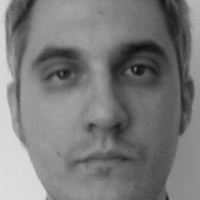
Dimitar Veljanovski
Work place: Skopje City General Hospital, Pariska B.B., 1000 Skopje, Macedonia
E-mail: dveljanovski@bolnica.org.mk
Website:
Research Interests: Computational Physics, Physics
Biography
Dimitar Veljanovski was awarded the degree in General Medicine from the Medical Academy, Sofia, Faculty of Medicine in 2006. During the years 2007 through 2011 Dr. Dimitar Veljanovski has been working on his specialization in diagnostic radiology at the Clinic of Radiology in the Clinical Center in Skopje. During the years 2003 through 2013, Dr. Dimitar Veljanovski has contributed a considerable number of manuscripts to conferences and symposiums and has also attended numerous training and seminars in the field of diagnostic radiology. Since August 2011, Dr. Dimitar Veljanovski is with the Skopje City General Hospital in the Department of Magnetic Resonance Imaging and he is an active member of the Macedonian Radiology Association and the European Radiology Society. Manuscript received January 21st, 2014; revised March 1st , 2014; accepted Month Date, Year
Author Articles
A Novel Approach to T2-Weighted MRI Filtering: The Classic-Curvature and the Signal Resilient to Interpolation Filter Masks
By Carlo Ciulla Farouk Yahaya Edmund Adomako Ustijana Rechkoska Shikoska Grace Agyapong Dimitar Veljanovski Filip A. Risteski
DOI: https://doi.org/10.5815/ijieeb.2016.01.01, Pub. Date: 8 Jan. 2016
This paper presents a novel and unreported approach developed to filter T2-weighetd Magnetic Resonance Imaging (MRI). The MRI data is fitted with a parametric bivariate cubic Lagrange polynomial, which is used as the model function to build the continuum into the discrete samples of the two-dimensional MRI images. On the basis of the aforementioned model function, the Classic-Curvature (CC) and the Signal Resilient to Interpolation (SRI) images are calculated and they are used as filter masks to convolve the two-dimensional MRI images of the pathological human brain. The pathologies are human brain tumors. The result of the convolution provides with filtered T2-weighted MRI images. It is found that filtering with the CC and the SRI provides with reliable and faithful reproduction of the human brain tumors. The validity of filtering the T2-weighted MRI for the quest of supplemental information about the tumors is also found positive.
[...] Read more.Applied Computational Engineering in Magnetic Resonance Imaging: A Tumor Case Study
By Carlo Ciulla Dijana Capeska Bogatinoska Filip A. Risteski Dimitar Veljanovski
DOI: https://doi.org/10.5815/ijigsp.2014.07.01, Pub. Date: 8 Jun. 2014
This paper solves the biomedical engineering problem of the extraction of complementary and/or additional information related to the depths of the anatomical structures of the human brain tumor imaged with Magnetic Resonance Imaging (MRI). The combined calculation of the signal resilient to interpolation and the Intensity-Curvature Functional provides with the complementary and/or additional information. The steps to undertake for the calculation of the signal resilient to interpolation are: (i) fitting a polynomial function to the signal, (ii) the calculation of the classic-curvature of the signal, (iii) the calculation of the Intensity-Curvature term before interpolation of the signal, (iv) the calculation of the Intensity-Curvature term after interpolation of the signal, (v) the solution of the equation of the two aforementioned Intensity-Curvature terms of the signal provides with the signal resilient to interpolation. The Intensity-Curvature Functional is the result of the ratio between the two Intensity-Curvature terms before and after interpolation. Because of the fact that the signal resilient to interpolation and the Intensity-Curvature Functional are derived through the process of re-sampling the original signal, it is possible to obtain an immense number of images from the original MRI signal. This paper shows the combined use of the signal resilient to interpolation and the Intensity-Curvature Functional in diagnostic settings when evaluating a tumor imaged with MRI. Additionally, the Intensity-Curvature Functional can identify the tumor contour line.
[...] Read more.Computational Intelligence in Magnetic Resonance Imaging of the Human Brain: The Classic-Curvature and the Intensity-Curvature Functional in a Tumor Case Study
By Carlo Ciulla Dijana Capeska Bogatinoska Filip A. Risteski Dimitar Veljanovski
DOI: https://doi.org/10.5815/ijieeb.2014.02.01, Pub. Date: 8 Apr. 2014
This research solves the computational intelligence problem of devising two mathematical engineering tools called Classic-Curvature and Intensity-Curvature Functional. It is possible to calculate the two mathematical engineering tools from any model polynomial function which embeds the property of second-order differentiability. This work presents results obtained with bivariate and trivariate cubic Lagrange polynomials. The use of the Classic-Curvature and the Intensity-Curvature Functional can add complementary information in medical imaging, specifically in Magnetic Resonance Imaging (MRI) of the human brain.
[...] Read more.Other Articles
Subscribe to receive issue release notifications and newsletters from MECS Press journals